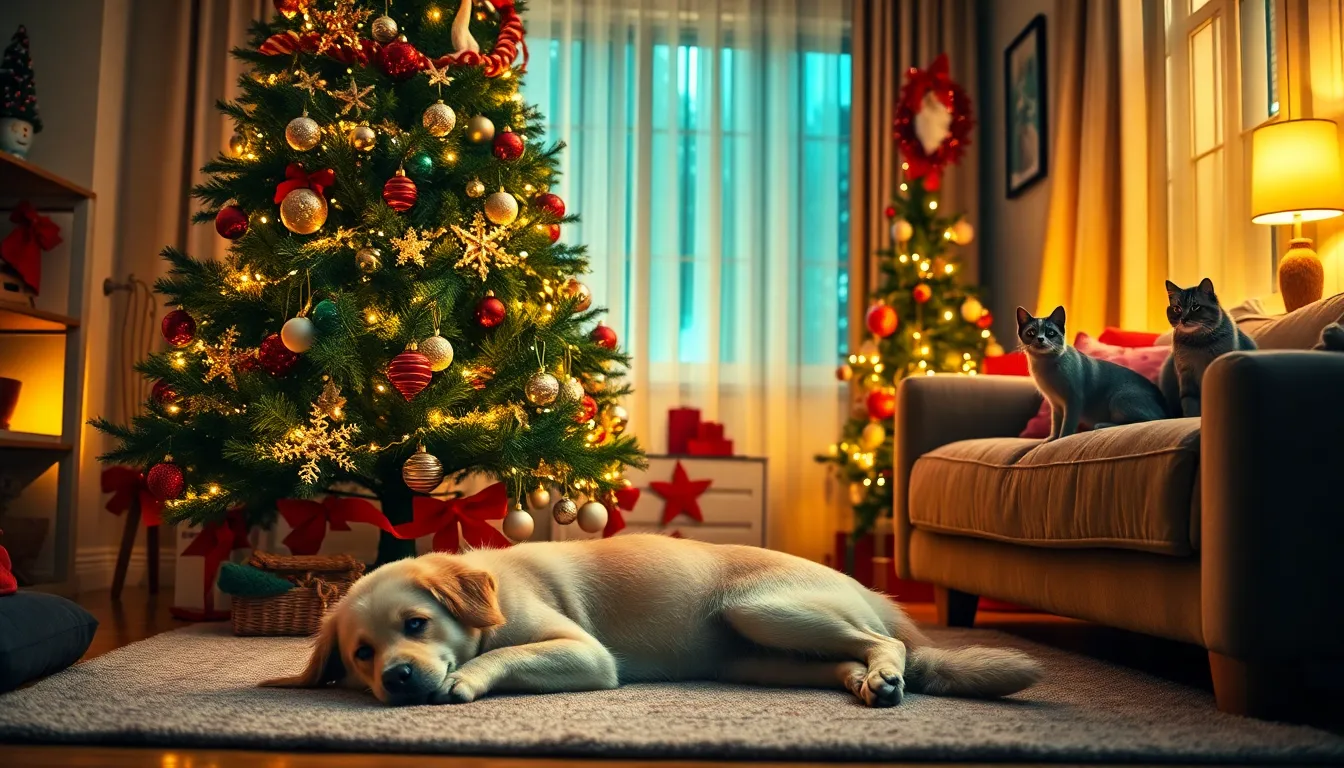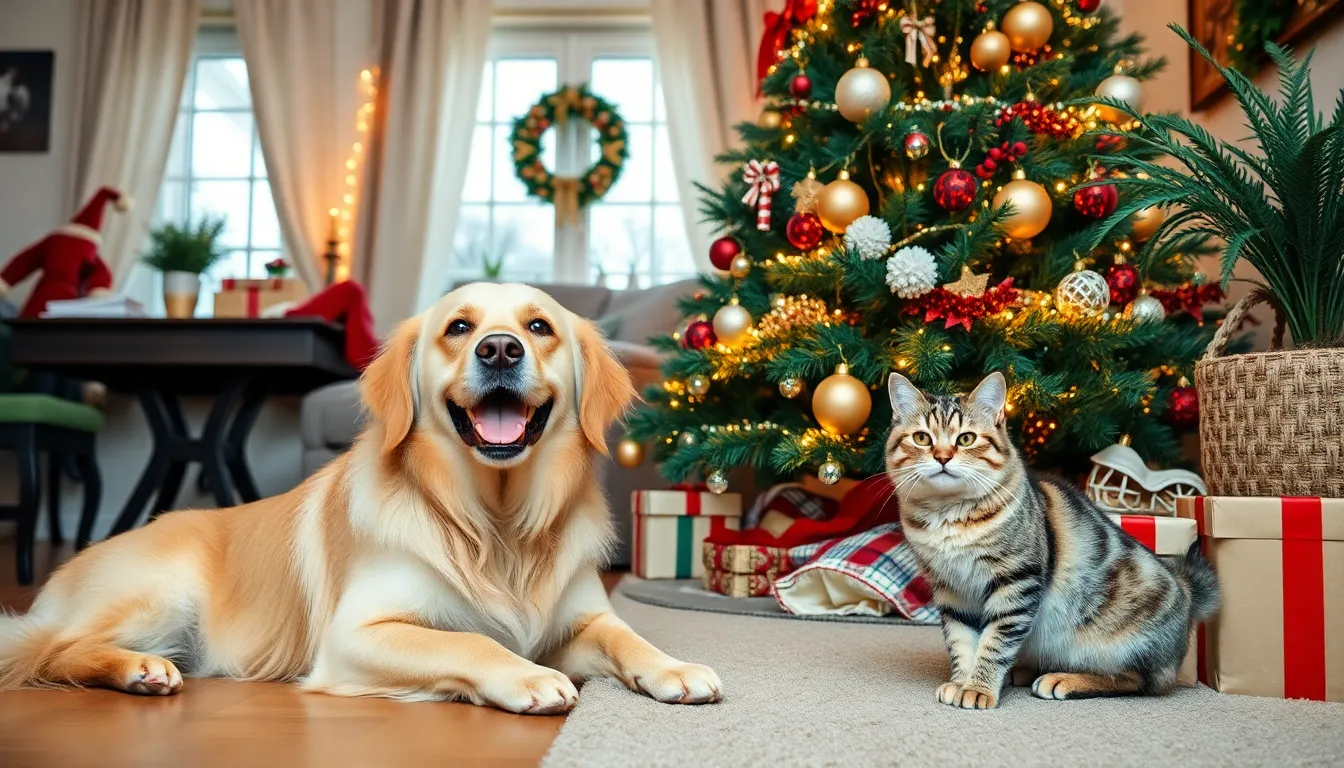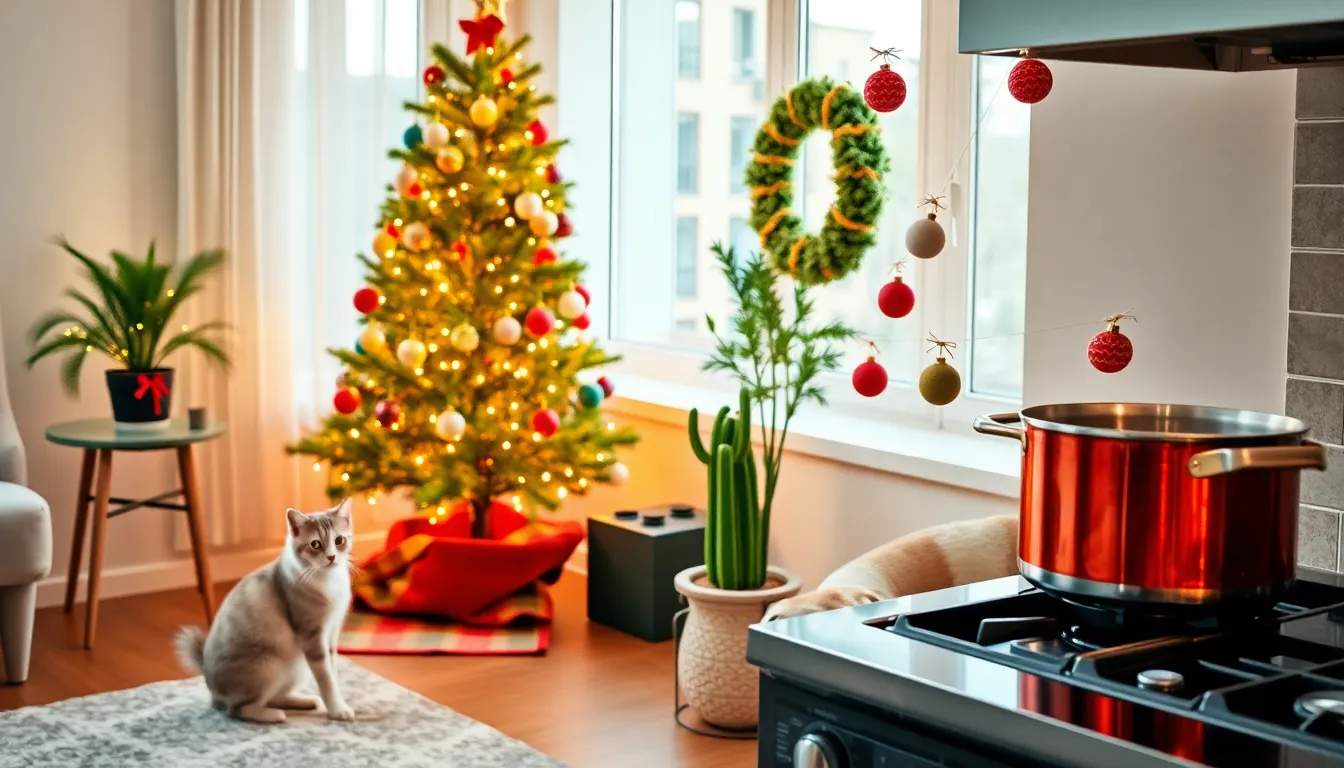As holiday cheer fills the homes of 94 million U.S. pet-owning households, implementing Pet-friendly holiday decorating strategies becomes crucial to prevent festive adornments from becoming serious dangers. Without such a thoughtful approach, what should be a time of celebration can quickly escalate into stress and emergency veterinary visits for companion animals.
Key Implications:
- Mandatory Pet Safety: For the 94 million U.S. households with pets, prioritizing animal safety through proactive planning and awareness during holiday decorating is a critical requirement, not an option.
- Comprehensive Hazard Management: Effective pet-friendly decorating demands identifying common holiday hazards, such as toxic plants, ingestible decor like tinsel, and electrical risks, and implementing specific mitigation strategies to protect pets.
- Sustained Vigilance and Adaptation: Ensuring pet well-being extends beyond initial setup, requiring continuous vigilance through regular checks, adapting strategies to individual pet behaviors, and maintaining a safe sanctuary amidst festive changes.

Key Message
For the 94 million U.S. households with pets, holiday decorating presents a unique set of challenges that demand careful consideration. Strategies are essential to ensure animal safety and well-being amidst these festive decorating risks. The joyous atmosphere of the holiday season can inadvertently introduce numerous hazards to curious or playful pets, transforming seemingly innocent decorations into potential dangers. Without a thoughtful approach to pet-friendly holiday decorating, what should be a time of celebration can quickly become a period of stress and emergency veterinary visits.
Proactive planning and awareness are not merely suggestions but crucial requirements for every pet owner during this time. The goal is to create an environment where pets can coexist safely with festive adornments, safeguarding them from preventable accidents and illnesses. Understanding potential risks and implementing preventative measures are the cornerstones of successful holiday safety for our animal companions. This dedication to their well-being ensures the entire household can enjoy the holidays without concern for their furry, feathered, or scaled family members.
Identifying Common Holiday Hazards for Pets
Many traditional holiday decorations, while beautiful, pose significant risks to pets. Recognizing these potential dangers is the first step toward effective pet-friendly holiday decorating. These hazards range from ingestible items to electrical dangers and potential physical injuries. A comprehensive understanding allows pet owners to make informed choices about their festive setups.
Christmas trees themselves can be a major concern. Unsecured trees may fall, causing injury. The water in the tree stand often contains fertilizers or preservatives, which are toxic if ingested. Furthermore, fallen pine needles can be sharp and irritating to paws, or if ingested, can cause internal discomfort or blockages. Glass ornaments, highly attractive to pets due to their sparkle, can shatter into dangerous shards if knocked down, leading to cuts or internal injuries if swallowed. Even seemingly innocuous items like ornament hooks or small decorative pieces present a choking hazard or can cause internal perforations.
Electrical lights, a staple of holiday decor, also carry inherent risks. Pets, particularly puppies and kittens, may chew on electrical cords, leading to electrocution or burns. Damaged cords can also start fires. Tinsel, ribbons, and garland, while festive, are particularly dangerous if ingested. They can cause linear foreign bodies, a severe condition where the material bunches up in the intestines, potentially requiring extensive surgery. Similarly, decorative plants like mistletoe, holly, and certain types of lilies are highly toxic to pets. Even poinsettias, though often overstated, can cause mild gastrointestinal upset if consumed in large quantities. Open flames from candles or fireplaces present burn risks and fire hazards, especially when a curious tail or nose gets too close. Lastly, unattended holiday food items or discarded gift wrappings, including batteries and silica gel packets, can also pose serious threats.
Implementing Proactive Pet-Friendly Decorating Strategies
To effectively mitigate these risks, implementing deliberate pet-friendly holiday decorating strategies is paramount. The focus should be on prevention and creating safe zones within the home. This approach allows families to enjoy the festive spirit without compromising their pets’ safety. Simple adjustments to decorating habits can make a world of difference in preventing accidents.
Begin by securing your Christmas tree firmly to a wall or ceiling using fishing line or strong wire. This prevents accidental tipping, which could injure pets or damage property. Block access to the tree water with a sturdy skirt or cover to prevent ingestion of potentially contaminated water. When choosing ornaments, opt for non-breakable alternatives made of plastic, wood, or felt. Place fragile, sentimental, or small, ingestible ornaments on higher branches, well out of a pet’s reach. It is highly recommended to completely avoid tinsel and similar string-like decorations, as they are a significant hazard. For electrical lights, use pet-safe cord covers or channel covers to prevent chewing. Ensure all lights are in good condition, without frayed wires, and unplug them when you leave the room or go to bed. Using battery-operated LED lights can further reduce electrical risks and heat.
Regarding holiday plants, the safest option is to choose pet-safe artificial alternatives or place real toxic plants in areas completely inaccessible to pets, such as on high shelves or in rooms with closed doors. Educate yourself on common toxic plants and their symptoms to react quickly if accidental ingestion occurs. Replace traditional open-flame candles with flameless, battery-operated LED candles, which provide ambiance without the burn or fire risk. When opening gifts, immediately collect and dispose of all ribbons, wrapping paper, and small decorative elements to prevent pets from playing with or ingesting them. Consider establishing a designated “pet-free” zone during parties or when new decorations are introduced, offering your pet a safe, quiet retreat from potential stressors and hazards.
Maintaining Vigilance Through the Season
Ensuring animal safety and well-being during the holidays extends beyond initial setup; it requires continuous vigilance throughout the season. Holiday decorations are not static, and pet behaviors can change, necessitating ongoing attention to maintain a secure environment. Regular checks of your decorated spaces are crucial. Inspect lights and cords daily for any signs of chewing or damage. Ensure that ornaments, especially those within reach, remain intact and secure. If you notice any decorations have been tampered with or knocked down, address the issue immediately. This proactive approach helps to identify and rectify potential hazards before they escalate into an emergency.
Furthermore, consider your pet’s personality and habits. A curious cat might see a hanging ornament as a toy, while a playful puppy might view electrical cords as chew toys. Adjust your pet-friendly holiday decorating strategies based on their individual tendencies. If you have guests, politely inform them of your pet safety rules, such as not feeding human food or leaving personal items within reach. Many holiday foods are toxic to pets, and items like medications or small belongings can be harmful if ingested. Keeping emergency contact information for your veterinarian and a pet poison control hotline readily accessible is also a vital safety measure. Despite all precautions, accidents can happen, and quick action can make a significant difference in your pet’s outcome. By maintaining constant awareness and preparedness, the 94 million U.S. households with pets can ensure a joyous and safe holiday season for every member of their family.

Data & Evidence
The vast presence of pets within American homes profoundly shapes consumer behavior and safety considerations, particularly during festive periods. As reported by the American Pet Products Association, 94 million households in the United States feature a pet. This staggering figure underscores the widespread integration of companion animals into family life across the nation, making their well-being a central concern for many homeowners during the holidays.
This demographic reality means that a significant majority of U.S. homes, roughly 70%, share their space with at least one animal. For these families, holidays are not just about human celebrations. They also involve ensuring a safe and joyful environment for their furry, feathered, or scaled companions. The sheer scale of pet ownership highlights why considerations for pet-friendly holiday decorating are not merely niche interests but rather mainstream imperatives.
The Pervasive Role of Pets in American Families
Understanding the scale of pet integration is crucial for appreciating its impact on daily life, including seasonal traditions. With 94 million households opening their doors to pets, these animals are truly considered integral family members. This strong emotional bond drives pet owners to prioritize their pets’ safety and comfort, especially when introducing new elements into their home environment.
The commitment to pet welfare means that decisions about holiday decorations extend beyond aesthetics alone. Pet owners consistently evaluate potential risks to their animals. This diligence applies to everything from selecting non-toxic plants to securing fragile ornaments. The American Pet Products Association’s data serves as a foundational metric for understanding this widespread pet-centric approach to household management.
This high incidence of pet ownership also means that any public health or safety campaigns related to household hazards must account for pets. During the holidays, traditional decorating practices can inadvertently pose risks. Therefore, broad awareness of these potential dangers is essential for a population with such extensive pet integration.
Implications for Holiday Safety and Pet-Friendly Decorating
The widespread presence of pets in 94 million households directly correlates with an increased potential for holiday-related pet incidents. Festive lights, sparkling ornaments, seasonal plants, and rich foods all present unique hazards that are often overlooked in homes without pets. For example, electrical cords from holiday lights can be tempting chew toys for curious puppies and kittens, potentially leading to shocks or burns.
Many traditional holiday plants, such as poinsettias, mistletoe, and lilies, are toxic if ingested by pets. These can cause symptoms ranging from mild gastrointestinal upset to severe organ damage. Similarly, small, breakable ornaments or tinsel can be swallowed, leading to choking hazards or internal obstructions that require emergency veterinary care. The scale of pet ownership means these risks are present in a vast number of homes.
Considering the magnitude of this pet population, veterinarians often observe an uptick in emergency visits during the holiday season. This surge is frequently attributed to pets ingesting foreign objects, consuming toxic foods, or suffering injuries related to decorations. The data from the American Pet Products Association underscores the critical need for proactive strategies in pet-friendly holiday decorating to mitigate these avoidable dangers.
Guiding Choices for Responsible Pet Owners
The evidence of 94 million pet-owning households acts as a powerful reminder for individuals and industries alike. For pet owners, it reinforces the importance of vigilance and informed decision-making during the holidays. Choosing decorations made from non-toxic, durable materials becomes paramount. Securing items out of paw’s reach is no longer optional but a necessary safety measure.
Many retailers and product manufacturers are responding to this market reality by offering specific pet-safe alternatives. This includes artificial plants that mimic festive botanicals without the toxicity, shatterproof ornaments, and cord covers for electrical wires. The substantial demand from millions of pet-owning families fuels this innovation in pet-friendly holiday decorating products.
Ultimately, the American Pet Products Association’s statistic is more than just a number; it represents a commitment to companion animals that permeates American culture. It serves as foundational data emphasizing why pet safety, particularly during high-risk times like the holidays, must be a central consideration for the majority of U.S. households.

Content Focus
The holiday season brings immense joy and festive cheer to many households. However, for pet owners, it also introduces a unique set of considerations to ensure the safety and well-being of their furry companions. Pet-friendly holiday decorating involves a proactive and thoughtful approach to mitigate common risks associated with seasonal adornments. Prioritizing their safety allows everyone, including pets, to enjoy the festivities without incident.
Safer Decorations: Material Choices and Placement
One of the most critical aspects of pet-safe decorating involves the careful selection of materials. Traditional holiday ornaments are often fragile, made of glass or delicate plastics that can easily shatter. If these break, sharp shards pose a significant risk of cuts or ingestion injuries to curious pets. A much safer alternative is to opt for shatterproof ornaments made from felt, fabric, or wood. These materials are durable and less likely to cause harm, even if accidentally dislodged by a playful pet.
Certain decorative items should be avoided entirely in homes with pets due to their high-risk nature. Tinsel, with its shimmering, enticing strands, is particularly dangerous. Pets, especially cats, are often drawn to its movement and sparkle, leading to ingestion. This can cause severe digestive issues or potentially fatal intestinal blockages requiring emergency veterinary care. Similarly, ribbons used for gift wrapping or tree embellishments present an identical ingestion hazard and should be kept out of reach or foregone completely.
Edible decor, while seemingly harmless, also poses considerable risks. Items like candy canes, popcorn garlands, or gingerbread ornaments can be irresistible to pets. Ingesting human foods, especially sugary or fatty treats, can lead to upset stomachs, vomiting, or diarrhea. More serious concerns arise if the edibles contain toxic ingredients such as chocolate or artificial sweeteners like xylitol. Furthermore, pets attempting to reach these attractive treats might knock over the Christmas tree, creating additional hazards.
Toxic Plants and Open Flame Hazards
Many traditional holiday plants, though beautiful, harbor hidden dangers for pets. Poinsettias, a common Christmas symbol, can cause mild gastrointestinal upset if ingested, leading to drooling or stomach irritation. However, other popular festive plants like mistletoe and holly berries are considerably more toxic. Ingesting these can lead to severe symptoms, including intense gastrointestinal distress, cardiovascular problems, and neurological issues, which can be fatal.
To avoid these risks, opt for safer, pet-friendly alternatives. The Christmas cactus, with its vibrant blooms, is a non-toxic option that adds festive color without posing a threat to animals. Artificial plants and trees are another excellent solution, providing all the aesthetic appeal of natural greenery without any toxicity concerns. Always verify the safety of any plant before introducing it into your home, consulting reliable resources like veterinary associations or pet-safe plant lists.
Ambiance is a key part of holiday decorating, but lighting choices must prioritize safety. Open-flame candles present obvious fire hazards and burn risks for pets. A curious wagging tail or a playful swat can easily knock over a lit candle, potentially starting a fire or causing severe burns to the animal. The safest solution is to replace open-flame candles with LED alternatives. These battery-operated lights mimic the warm glow without any heat or flame, ensuring both pet safety and peace of mind. Additionally, ensure electrical cords for string lights are secured and out of reach to prevent chewing, which can lead to electric shock or oral injuries.
Securing the Christmas Tree and Managing Scents
The Christmas tree itself can be a major attraction and potential hazard for pets. A wobbly or unstable tree is an open invitation for a curious cat to climb or a playful dog to investigate. To prevent accidents, a sturdy, wide base for the tree stand is essential. For even greater security, especially with larger trees or particularly active pets, consider additional anchoring. Using strong wire or fishing line to secure the tree to a wall or ceiling hook provides crucial stability, preventing it from tipping over. This measure is particularly important if the tree is not placed against a wall or near furniture that pets could use to jump from.
Beyond physical hazards, the sensory environment created by holiday scents can also impact pets. Scented diffusers and plug-ins, commonly used to infuse homes with festive aromas, often contain essential oils or synthetic chemicals. These can be overwhelming or irritating to a pet’s highly sensitive olfactory system. Some essential oils can even be toxic if inhaled in high concentrations, absorbed through the skin, or ingested. It is advisable to use such products sparingly, if at all, and always in well-ventilated areas where pets cannot directly access them.
Natural alternatives offer a much gentler way to enjoy holiday fragrances. A simmering pot of cloves, cinnamon sticks, and orange rinds provides a delightful, natural aroma that is generally safer for pets. This method avoids concentrated chemicals and allows for better control over the intensity of the scent, ensuring it does not overwhelm your pet’s senses. Always place these natural diffusers in areas completely inaccessible to pets.
Prioritizing Your Pet’s Comfort and Sanctuary
Amidst all the festive changes, it is crucial not to overlook your pet’s emotional well-being. Holiday festivities often bring increased visitor traffic, altered daily routines, and a plethora of new sights, sounds, and smells, all of which can be overwhelming for animals. Maintaining a pet’s familiar sanctuary is vital for managing their stress levels during this busy time. Avoid moving their favorite toys, bedding, or comfort items unless absolutely necessary. Their designated safe space—whether a bed, crate, or a quiet, secluded corner—should remain consistently accessible and undisturbed.
If changes to their environment are unavoidable, introduce them gradually to minimize anxiety. For example, if a pet’s usual resting spot becomes a high-traffic area, begin acclimating them to a new, quiet retreat before holiday guests arrive. Provide new enrichment toys or familiar comfort items in this designated safe zone. Ensuring that your pet has a refuge from the holiday hustle and bustle is a significant component of creating a truly pet-friendly holiday decorating scheme. Ultimately, the goal is to cultivate a joyous and safe environment for every member of the family, including our cherished four-legged friends.
Featured image generated using Flux AI
Behind The Hedges: “Pet-friendly holiday decorating”
